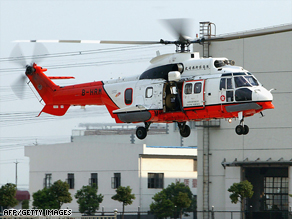
The transport helicopter that crashed into the North Sea this month suffered a "catastrophic failure" of its main rotor gearbox that caused the blades to separate from the aircraft and slice off the tail, accident investigators said.
The rotor blades detached from the helicopter and then struck the tail, causing the tail boom and pylon — which holds the tail rotor — to become severed from the fuselage, the Air Accidents Investigations Branch (AAIB) said. The findings came in an interim report that describes the April 1 crash in vivid detail. All 16 people aboard the Super Puma helicopter died when it went down about 11 miles off Scotland’s northeastern coast. The chopper had been on its way from a gas platform to Aberdeen when it went down. The report says the crash happened 50 minutes into a 70-minute trip from the Miller Platform in mostly clear skies and a light wind. The combined cockpit voice and flight data recorder showed that 12 seconds after the co-pilot radioed his estimated arrival time, one of the pilots made a mayday call, then radioed the helicopter’s position. The radar controller then tried unsuccessfully to contact the crew. Radar information shows the chopper flying toward Aberdeen at 2,000 feet, climbing momentarily to 2,200 feet, then turning right and descending rapidly. A witness in a supply vessel two miles away heard the helicopter and saw it descend rapidly before hitting the surface of the sea, the interim report says. “Immediately after impact, he saw the four main rotor blades, still connected at their hub, strike the water,” the report says. “Around this time, he also heard two bangs close together.
Don’t Miss
Copter ditches into sea off Scotland
All 18 survive helicopter crash off Scotland
“He immediately raised the alarm and the ship turned towards the accident site, which by now was marked by a rising column of gray, then black, smoke.” The ship launched a fast rescue boat, which arrived to find “an area of disturbed water, roughly 150 meters (164 yards) in diameter containing debris from the helicopter,” the report said. The AAIB did not say why it believes the main rotor gearbox failed. It said it was still analyzing the data recorder, which contained “some system warnings,” as well as the gearbox. In the meantime, the AAIB is issuing safety recommendations urging further checks and enhanced monitoring of the gearbox on all helicopters of the same type, the AS332L2 Super Puma. It also recommended that the chopper’s manufacturer, Eurocopter, improve the warning systems on the helicopter to provide adequate alerts. The AS332L2 is an older version of the Super Puma, an aircraft used often for offshore transport but also search-and-rescue missions and emergency work, like firefighting and medical transport, according to Eurocopter. The helicopter’s operator was Bond Offshore Helicopters, which runs regular flights between Aberdeen and oil and gas platforms in the North Sea. Of the 16 people who died in the April 1 accident, two were crew members and the rest were passengers, including 10 members of the drilling crew on the Miller Platform.